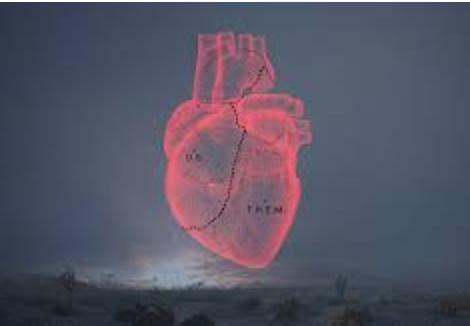Carne y Arena: “Flesh and Sand”

I was ushered into a pitch-black room at the LA County Museum of Art. From there I opened a steel door and entered a cold steel room with steel benches. The floor was littered with dirty, battered shoes. I recognized them, because they came from a collection of artifacts that I maintain at USC – items left on desert trails by migrants entering from Sonora, Mexico, into Arizona. I sat down and removed my own shoes and put them into a steel cabinet, and waited, shivering. It was meant to replicate the short-term holding rooms of migrant detention centers. An alarm went off, a red light flashed, and I went through another door into a big space covered in rough sand and dirt. One wall was made of corrugated steel formerly lining the border wall at Naco, Arizona. The steel originally was used for landing pads for helicopters in the Vietnam War. A pair of museum staffers mounted me with a tethered “mochila”, or backpack, reminiscent of the ones in our artifact collection. They put virtual reality goggles mounted with an IPhone on my head, and earphones over my ears. Suddenly I was in the desert, just before dawn, feeling the wind, walking with the sand underfoot, gazing at dimly glowing mountains in the distance, dodging clusters of cactus and brush. I looked all around me at the magnificent, forbidding landscape. Figures appeared: migrants heading north. Then the tremendous whoosh of a helicopter, sweeping the ground with a floodlight, throbbing my bones and blasting wind on our heads. Then the headlights of migra (Border Patrol) trucks, lighting up blinding swirls of dust. Officers in fatigues aiming big rifles topped with flashlights at us, yelling. Migrants crying out. A migra officer stormed at me and merged into my body in a pixellated mist. We were ordered to drop on our knees: I dropped, with my hands over my head. I turned and saw a woman who was moaning as another migrant tended to her painfully blistered feet. Her journey through the desert was already over before migra showed up.
I will leave the rest to your imagination, and to your turn to experience this profound installation yourselves. (Read more about it in this LA Times article.) It is sold out through September: sometime that month it will open up again for ticket sales, so check the LACMA site regularly. Only one person can experience this installation at a time, so access is very limited. Inarritu introduced Carne y Arena at the Cannes Film Festival earlier this year, and it was received as a revolution in the film industry, leaving its old boundaries and conventions behind.
I left the virtual desert in tears. I have walked those migrant trails many times on the spring break trips I lead for USC students to southern Arizona to learn about interfaith border justice activism. These walks are emotionally fraught, as we sense for ourselves what it is like for migrants to pass through one of the harshest environments on earth. The landscape of Carne y Arena was very familiar (except that it included Joshua trees, which are not to be found in the Sonoran Desert along the border. Only a desert rat like myself would care about such a trivial detail!) But Carne y Arena took the empathy I already felt to another level. My Arizona artist friends Valarie James and Antonia Gallegos also went through the installation yesterday afternoon. All of us were left speechless, shaking our heads as if trying to wake up from an intense dream. Val and Antonia had gathered the artifacts from the desert trails which were used as models by the animators of Carne y Arena, Flesh and Sand, under the direction of Alejandro Inarritu, the Oscar-winning filmmaker. He came to my office about six months ago to look at the collection, which Val and Antonia had entrusted to me for keeping here at the University of Southern California. I have arranged many exhibitions of these artifacts. (Let me know if you would like to host such an event.) In our conversation, as we looked at the shoes, “carpet slippers” placed over shoes to cover tracks in the sand, backpacks including little ones for kids with Winnie the Pooh logos, and personal items, his commitment to changing hearts and minds about undocumented immigrants was palpable. Carne y Arena is the product of his passion. He has not only created an experience that powerfully induces empathy and compassion, he has demonstrated the literally awesome potential that virtual reality holds as a vehicle for social and political change. Carne y Arena includes a dream-like sequence that is suggestive of the way this technology can be employed to evoke mystical experiences. How can spiritual and religious teachers join with entertainment professionals to put VR to work as a medium for communion with the divine?
Alejandro Inarritu drops a depth-charge into the souls of all who experience Carne y Arena. And he cuts a new trail in the desert of Hollywood toward a promised land of kindness and justice. Let us walk it through political action for protecting the undocumented in our midst, and let us follow him in employing this entertainment technology for social and spiritual progress.
JIM BURKLO
Website: JIMBURKLO.COM Weblog: MUSINGS Follow me on twitter: @jtburklo
See the GUIDE to my articles and books
Associate Dean of Religious Life, University of Southern California
